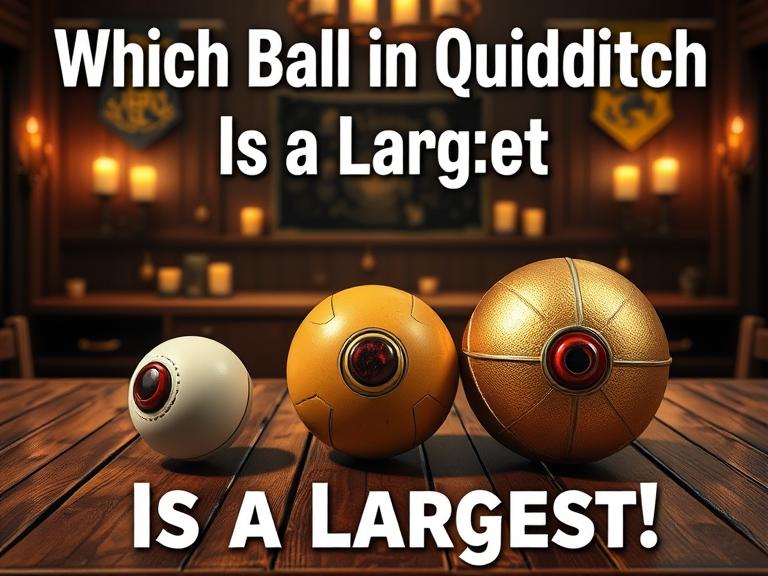Which Ball in Quidditch Is the Largest? Quidditch, the beloved wizarding sport from J.K. Rowling’s Harry Potter series, features four magical balls that each play a unique role in the game. Among these, one stands out as the largest and most imposing—the Quaffle.
In this article, we’ll explore:
- The four balls used in Quidditch
- Why the Quaffle is the largest
- How its size affects gameplay
- Comparisons with other magical sports equipment
Table of Contents
The Four Balls of Quidditch
Quidditch involves:
- Quaffle (scoring ball)
- Bludgers (attack balls)
- Golden Snitch (game-ending ball)
- Bulgarian Bludger (unofficial variant)
1. The Quaffle – The Largest Ball
- Diameter: ~12 inches (30 cm)
- Weight: ~5 lbs (2.3 kg)
- Material: Leather, enchanted for grip
- Purpose: Scored through hoops for 10 points
Why is it the largest?
- Easier for Chasers to catch and throw.
- Visible to spectators in fast-paced matches.
- Must be durable for constant handling.
2. Bludgers – The Dangerous Balls
- Diameter: ~10 inches (25 cm)
- Weight: ~15 lbs (6.8 kg) – Heavier than the Quaffle!
- Material: Iron, bewitched to attack players
- Purpose: Disrupt opponents (handled by Beaters)
Key Difference:
- Smaller than the Quaffle but much heavier.
- Moves independently (unlike the Quaffle).
3. The Golden Snitch – The Smallest Ball
- Diameter: ~2.5 inches (6 cm) – Walnut-sized
- Weight: Minimal (floats like a butterfly)
- Material: Gold-plated, with wings
- Purpose: Catching it ends the game (150 points)
4. Bulgarian Bludger (Unofficial Variant)
- Seen in the 1994 Quidditch World Cup (Harry Potter lore).
- Larger and faster than standard Bludgers.
Why Isn’t the Bludger the Largest?
Despite being heavier, Bludgers are smaller because:
✔ Aerodynamics: Easier to fly at high speeds.
✔ Intimidation Factor: Small but deadly.
✔ Tradition: Quaffle size standardized for fairness.
Quidditch Ball Size Comparison Chart
| Ball | Diameter | Weight | Purpose |
|---|---|---|---|
| Quaffle | 12 in (30 cm) | 5 lbs | Scoring (10 pts per goal) |
| Bludger | 10 in (25 cm) | 15 lbs | Disrupting players |
| Snitch | 2.5 in (6 cm) | <1 lb | Game-ender (150 pts) |
How Does the Quaffle’s Size Impact Gameplay?
- Easier Handling: Chasers need a large, grippy ball for quick passes.
- Visibility: Fans can track the primary scoring object.
- Durability: Withstands rough play (unlike the fragile Snitch).
FAQs About Quidditch Balls
1. Is the Quaffle bigger than a Muggle soccer ball?
- Yes! A soccer ball is ~9 inches (22 cm), while the Quaffle is ~12 inches.
2. Why is the Snitch so small?
- Designed to be hard to catch, rewarding Seekers’ skill.
3. Are Bludgers really heavier than Quaffles?
- Yes—iron construction makes them 3x heavier despite being smaller.
4. Has the Quaffle size ever changed?
- In the Middle Ages, it was just a patched-up leather ball (smaller).
5. Could a Muggle play Quidditch with these balls?
- Without magic, Bludgers wouldn’t move, and the Snitch wouldn’t fly!
6. What’s the hardest ball to handle?
- Bludgers—they attack players autonomously!
Real-Life Quidditch (Muggle Adaptation)
- Non-magical leagues use:
- A volleyball (Quaffle).
- Dodgeballs (Bludgers).
- A tennis ball in a sock (Snitch).
Final Verdict: The Quaffle Wins for Size!
While the Bludger is heavier, the Quaffle is undeniably the largest ball in Quidditch—a key feature for its role in the game.
Did You Know?
- The Quaffle was originally non-magical (just a regular ball!).
- In the 1612 Quidditch Cup, a Bludger knocked out all players except the Seeker!
(Sources: J.K. Rowling’s Quidditch Through the Ages, Pottermore.)




